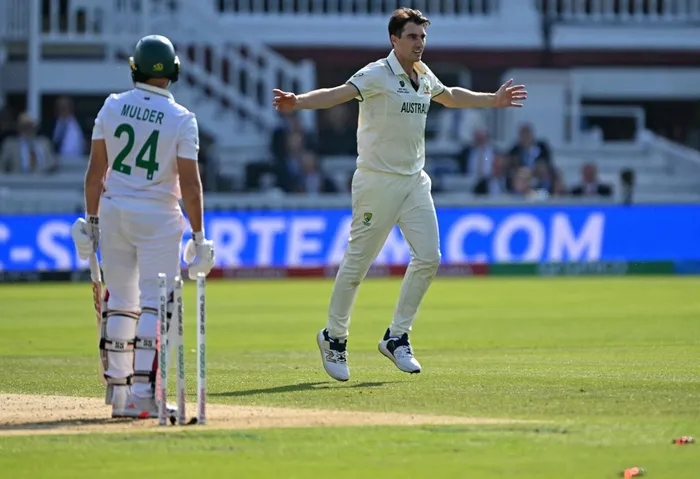Proteas batting dilemma: Will Wiaan Mulder or Zubayr Hamza slot in at No 3 in Zimbabwe Tests?
CRICKET

TIME TO MAKE A DIFFERENCE Proteas all-rounder Wiaan Mulder looks on after being dismissed by Australian captain Pat Cummins. Photo: AFP
Image: AFP
One of the key topics in the Proteas camp heading into the two-match Test series against Zimbabwe in Bulawayo later this week is whether Wiaan Mulder will continue to bat at No 3 for the foreseeable future.
The 27-year-old did not look best suited for the position in the first innings of the World Test Championship final at Lord’s earlier this month, despite having lasted 44 deliveries against one of the best bowling attacks Australia have ever had.
However, batting at No 3 is not only about surviving, but also about being able to transfer pressure back to the bowling attack, a feat that Mulder executed well in the second innings in London, where he scored 27 off 50 balls.
In the current Test squad, there is a specialist No 3 batter in Zubayr Hamza, who, despite having had his own run there previously, will most likely be considered for the position for Saturday’s first day against Zimbabwe.
Speaking to the media on Wednesday, Mulder told the media that it is unclear where he will bat in the series, as coach Shukri Conrad has not informed the squad of his plans as yet.
Moreover, Mulder highlighted that there is a chance he could take on the position once again at the Queens Sports Club in Bulawayo.
“I wish I could tell you where I’m going to bat. I don’t know. Shukri announces the team the day before. He doesn’t speak to us in between. So, it’s not just me that doesn’t know,” said Mulder.
“I think I’ve got an idea from the recent past that there’s a chance I can bat at three.”
Technically, Mulder is without a doubt a top-order batter, but at the moment, he lacks experience.
However, how else can anyone gather experience if they are not given an opportunity to do so?
Mulder reckons he has got the game to bat in that position for the world Test champions.
“Batting at three, I think technically, I’ve worked really hard to get my game in a place to be able to manage with the new ball and score runs during the new ball phase of every innings,” he said.
“I think I learned a lot playing in the WTC final about batting at three. That was only the second time I batted at three in Test cricket without a broken hand.
“So, the way I want to go about it is be positive and have good intent from ball one.
“I think in the first innings in the WTC final, it taught me that the positions I need to get into to be able to transfer the pressure are more important than just surviving.
“Even though you can look at it however you want, that (second innings of WTC final) was an important phase of the game, not to lose wickets. That’s history now.
“But I think the important thing about it is that we look to score all the time, and that’s a mindset that, when I play that way, I play at my best.
“I think the second innings in the WTC final represented that a bit more about what I want to bring. It’s been a conversation with Shuks from the beginning of batting at three.
“It’s something I haven’t done a lot before in first-class cricket.
“So, I’m going to have to figure it out, and sometimes people will say figuring it out on the job is the deep end.
“Other people will say it’s the best place to learn, because you actually get proof that the method you’re going to try and use and commit to will work.
“So, I look at it more on the optimistic side, and try and be a bit more positive and get into strong positions to transfer pressure.”
Related Topics: